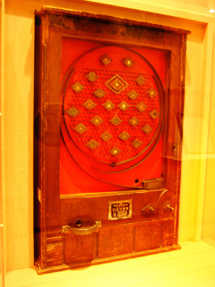
 A historical Pachinko machine, a relative of Francis Galton's
Quincunx and the AAKKOZZLL, and the predecessor of the widely popular amusement
in today's Japan. Click here for more info – photo
by Gnsin.
A historical Pachinko machine, a relative of Francis Galton's
Quincunx and the AAKKOZZLL, and the predecessor of the widely popular amusement
in today's Japan. Click here for more info – photo
by Gnsin.
The world that we have to deal with politically is out of reach, out of
sight, out of mind. It has to be explored, reported, and imagined. Man
is no Aristotelian god contemplating all existence at one glance. He is
the creature of an evolution who can just about span a sufficient portion
of reality to manage his survival, and snatch what on the scale of time
are but a few moments of insight and happiness. Yet this same creature
has invented ways of seeing what no naked eye could see, of hearing what
no ear could hear, of weighing immense masses and infinitesimal ones, of
counting and separating more items than he can individually remember. He
is learning to see with his mind vast portions of the world that he could
never see, touch, smell, hear, or remember. Gradually he makes for himself
a trustworthy picture inside his head of the world beyond his reach.
Those features of the world outside which have to do with the behavior of other
human beings, in so far as that behavior crosses ours, is dependent upon us,
or is interesting to us, we call roughly public affairs. The pictures inside
the heads of these human beings, the pictures of themselves, of others, of their
needs, purposes, and relationship, are their public opinions. Those pictures
which are acted upon by groups of people, or by individuals acting in the name
of groups, are Public Opinion with capital letters. And so in the chapters which
follow we shall inquire first into some of the reasons why the picture inside
so often misleads men in their dealings with the world outside. Under this heading
we shall consider first the chief factors which limit their access to the facts.
They are the artificial censorships, the limitations of social contact, the comparatively
meager time available in each day for paying attention to public affairs, the
distortion arising because events have to be compressed into very short messages,
the difficulty of making a small vocabulary express a complicated world, and
finally the fear of facing those facts which would seem to threaten the established
routine of men's lives.
The analysis then turns from these more or less external
limitations to the question of how this trickle of messages from the outside
is affected by the stored up images, the preconceptions, and prejudices which
interpret, fill them out, and in their turn powerfully direct the play of
our attention, and our vision itself. From this it proceeds to examine how
in the individual person the limited messages from outside, formed into a
pattern of stereotypes, are identified with his own interests as he feels
and conceives them. In the succeeding sections it examines how opinions are
crystallized into what is called Public Opinion, how a National Will, a Group
Mind, a Social Purpose, or whatever you choose to call it, is formed.
Lippmann, Walter Public Opinion, 1922 p7
Complete text online
at http://en.wikisource.org/wiki/Public_Opinion

